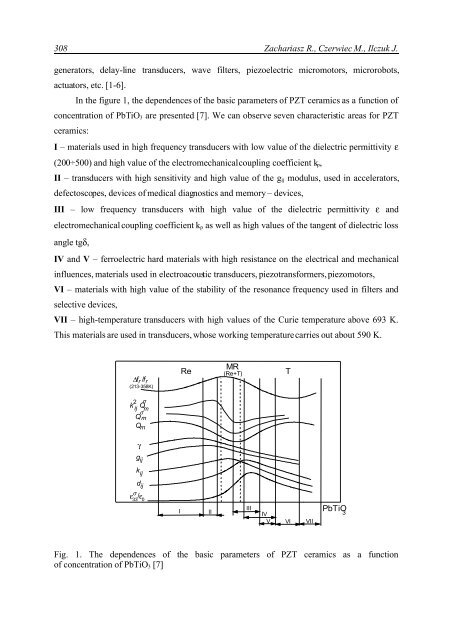time stability of mechanical and dielectric parameters in the pzt type ...
time stability of mechanical and dielectric parameters in the pzt type ...
time stability of mechanical and dielectric parameters in the pzt type ...
Create successful ePaper yourself
Turn your PDF publications into a flip-book with our unique Google optimized e-Paper software.
308 Zachariasz R., Czerwiec M., Ilczuk J.<br />
generators, delay-l<strong>in</strong>e transducers, wave filters, piezoelectric micromotors, microrobots,<br />
actuators, etc. [1-6].<br />
In <strong>the</strong> figure 1, <strong>the</strong> dependences <strong>of</strong> <strong>the</strong> basic <strong>parameters</strong> <strong>of</strong> PZT ceramics as a function <strong>of</strong><br />
concentration <strong>of</strong> PbTiO 3 are presented [7]. We can observe seven characteristic areas for PZT<br />
ceramics:<br />
I – materials used <strong>in</strong> high frequency transducers with low value <strong>of</strong> <strong>the</strong> <strong>dielectric</strong> permittivity ε<br />
(200÷500) <strong>and</strong> high value <strong>of</strong> <strong>the</strong> electro<strong>mechanical</strong> coupl<strong>in</strong>g coefficient k p ,<br />
II – transducers with high sensitivity <strong>and</strong> high value <strong>of</strong> <strong>the</strong> g ij modulus, used <strong>in</strong> accelerators,<br />
defectoscopes, devices <strong>of</strong> medical diagnostics <strong>and</strong> memory – devices,<br />
III – low frequency transducers with high value <strong>of</strong> <strong>the</strong> <strong>dielectric</strong> permittivity ε <strong>and</strong><br />
electro<strong>mechanical</strong> coupl<strong>in</strong>g coefficient k p as well as high values <strong>of</strong> <strong>the</strong> tangent <strong>of</strong> <strong>dielectric</strong> loss<br />
angle tgδ,<br />
IV <strong>and</strong> V – ferroelectric hard materials with high resistance on <strong>the</strong> electrical <strong>and</strong> <strong>mechanical</strong><br />
<strong>in</strong>fluences, materials used <strong>in</strong> electroacoustic transducers, piezotransformers, piezomotors,<br />
VI – materials with high value <strong>of</strong> <strong>the</strong> <strong>stability</strong> <strong>of</strong> <strong>the</strong> resonance frequency used <strong>in</strong> filters <strong>and</strong><br />
selective devices,<br />
VII – high-temperature transducers with high values <strong>of</strong> <strong>the</strong> Curie temperature above 693 K.<br />
This materials are used <strong>in</strong> transducers, whose work<strong>in</strong>g temperature carries out about 590 K.<br />
∆ f r / f r<br />
(213-358K)<br />
Re<br />
MR<br />
(Re+T)<br />
T<br />
2 σ<br />
k ij Q<br />
m<br />
σ<br />
Q m<br />
Q m<br />
γ<br />
g ij<br />
k ij<br />
d ij<br />
σ<br />
ε / ε 33 0<br />
I<br />
II<br />
III<br />
IV<br />
V<br />
VI<br />
VII<br />
PbTiO<br />
3<br />
Fig. 1. The dependences <strong>of</strong> <strong>the</strong> basic <strong>parameters</strong> <strong>of</strong> PZT ceramics as a function<br />
<strong>of</strong> concentration <strong>of</strong> PbTiO 3 [7]

















